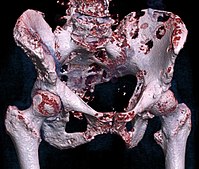
Photo from wikipedia
HYPOTHESIS We hypothesized that biomechanical parameters typically associated with glenoid implant failure after anatomic total shoulder arthroplasty (aTSA) would be correlated with preoperative glenoid bone quality. METHODS We developed an… Click to show full abstract
HYPOTHESIS We hypothesized that biomechanical parameters typically associated with glenoid implant failure after anatomic total shoulder arthroplasty (aTSA) would be correlated with preoperative glenoid bone quality. METHODS We developed an objective automated method to quantify preoperative glenoid bone quality in different volumes of interest (VOIs): cortical bone, subchondral cortical plate, subchondral bone after reaming, subchondral trabecular bone, and successive layers of trabecular bone. Average computed tomography (CT) numbers (in Hounsfield units [HU]) were measured in each VOI from preoperative CT scans. In parallel, we built patient-specific finite element models of simulated aTSAs to predict cement stress, bone-cement interfacial stress, and bone strain around the glenoid implant. CT measurements and finite element predictions were obtained for 20 patients undergoing aTSA for primary glenohumeral osteoarthritis. We tested all linear correlations between preoperative patient characteristics (age, sex, height, weight, glenoid bone quality) and biomechanical predictions (cement stress, bone-cement interfacial stress, bone strain). RESULTS Average CT numbers gradually decreased from cortical (717 HU) to subchondral and trabecular (362 HU) bone. Peak cement stress (4-10 MPa) was located within the keel hole, above the keel, or behind the glenoid implant backside. Cement stress, bone-cement interfacial stress, and bone strain were strongly negatively correlated with preoperative glenoid bone quality, particularly in VOIs behind the implant backside (subchondral trabecular bone) but also in deeper trabecular VOIs. CONCLUSION Our numerical study suggests that preoperative glenoid bone quality is an important parameter to consider in aTSA, which may be associated with aseptic loosening of the glenoid implant. These initial results should now be confronted with clinical and radiologic outcomes.
Journal Title: Journal of shoulder and elbow surgery
Year Published: 2017
Link to full text (if available)
Share on Social Media: Sign Up to like & get
recommendations!